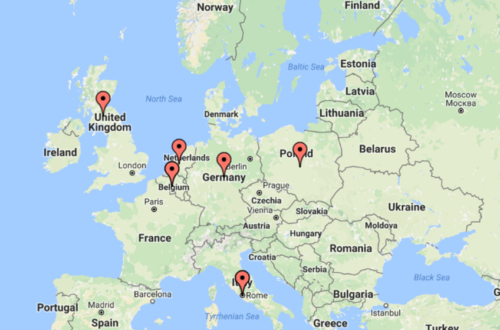
Special Section: Network Analysis and Comparative Methods
Special Section: Network Analysis and Comparative Law Methods
The German Law Journal is proud to announce the publication of a special collection of articles and comments (Volume 18, No. 3) that take up the unceasing challenge posed by the question: how should we compare? The collection was inspired by the debate that coursed among the editors as we considered – and ultimately accepted – the submission of Mattias Derlén and Johan Lindholm entitled “Peek-A-Boo, It’s a Case Law System! Comparing the European Court of Justice and the United States Supreme Court from a Network Perspective.” It was not the first time – following our usual, blind peer-review – that the Journal agreed to publish an article from two of Europe’s leading proponents of Network Analysis as a comparative law method. We are pleased that we could publish these insightful contributions. But we also recognize that they involve a not uncontroversial approach to comparative law, one that might seem at odds with previous work we have published that engages with and embraces a critical comparative posture. On the one hand, the special section is meant to acknowledge the increasing role played by empirical, data-driven analysis in comparative law. On the other hand, the special section is meant to bring those approaches into dialogue with critical, contextual, and hermeneutical comparisons.
The result is a stimulating set of texts, opening with Derlén’s and Lindholm’s network based analysis of the use of precedent at the Supreme Court of the United States (SCOTUS) and the Court of Justice of the European Union (CJEU). The similarities they see in the patterns (“networks”) of citation to previous decisions at those courts suggest to them that the CJEU approximates the “case law” technique and method of the SCOTUS. Jens Frankenreiter, in a response to this article, raises a number of questions about the difficulties Network Analysis faces in general, including coding biases and conceptual blind spots. Frankenreiter notes, for example, that Derlén and Lindholm devote little attention to the theoretical question: what constitutes a “case law” system. Frankenreiter also challenges Derlén and Lindholm on their own terms, suggesting that their analysis of the data could be more refined. But Frankenreiter, a Senior Researcher at the Bonn Max Planck Institute (which has pioneered the economic analysis of the law against the grain of Germany Rechtswissenschaft’s dogmatism), is not hostile to empirical research of the kind Derlén and Lindholm pursue. Despite the shortcomings he sees, Frankenreiter in convinced that Network Analysis can “make [a] substantial contribution to empirical legal research.” This view is more vigorously advanced by GLJ editors Niels Petersen and Emanuel Towfigh, who are also respected practitioners of empirical legal analysis. Their essay serves as a disciplined reply to common criticisms leveled against the use of Network Analysis (and empirical methods more generally) in comparative law. They acknowledge, for example, that empirical work requires a representational model that is not a “reality.” But the subjectivity involved in the selection of a representation of reality that can be quantified can redeemed, they argue, by “testing [the model] against ‘reality’,” a practice that “adds an additional layer of scrutiny and thus an enriched understanding of the phenomenon.” This is a theoretical – if not metaphysical – defense of an approach to research that is otherwise firmly grounded in empirical facts and data.
A critical school works with foreign law and foreign legal phenomena as a hermeneutical practice, worlds away from these empirical approaches to comparative law. Pierre Legrand is one of the most prolific and provocative of these scholars. In this special collection Legrand and Simone Glanert offer a charged review of Günter Frankenberg’s new book Comparative Law as Critique. Remarkably, Frankenberg’s near total-rejection of orthodox positions in comparative law does not go far enough for Glanert and Legrand, who insist that “Frankenberg’s critical aspirations are […] incompletely radical, his oppositional edge insufficiently sharp, to operate as comparative law’s governing epistemic practice.” They won’t be satisfied until comparative law declaims anything like the “reality” (reduced to data in a Network Analysis) that Derlén and Lindholm unreflexively invoke. It would be impossible to more effectively illustrate the discipline’s poles than to juxtapose Derlén and Lindholm with Glanert and Legrand. The former, utterly convinced of the existence and relevance of their data and its explanatory power. The latter insisting that subjectivities and contingencies once again thwart our urge for objective understanding.
In her impressive article German Law Journal editor Jule Mulder offers a kind of compromise between these poles. Her comprehensive assessment of the role comparative law has played in the European project assumes the “reality” of the law and legal system she is studying. But she wants to be guided by the applied potential of the lessons of Glanert and Legrand teach us – about subjectivity, and context, and contingency – without having to abandon the comparative law discipline altogether. She urges a respect for culture and pluralism that is missing from too much of the European agenda. And she offers us something more. The obvious debt she owes to Frankenberg’s work reminds us of his seminal place in anything that we might be determined (or tempted) to call the discipline of “comparative law.”
If one were committed to counting, it would be interesting to add-up the number of times Derlén and Lindholm cite Frankenberg. His is a truly profound “network” effect.







